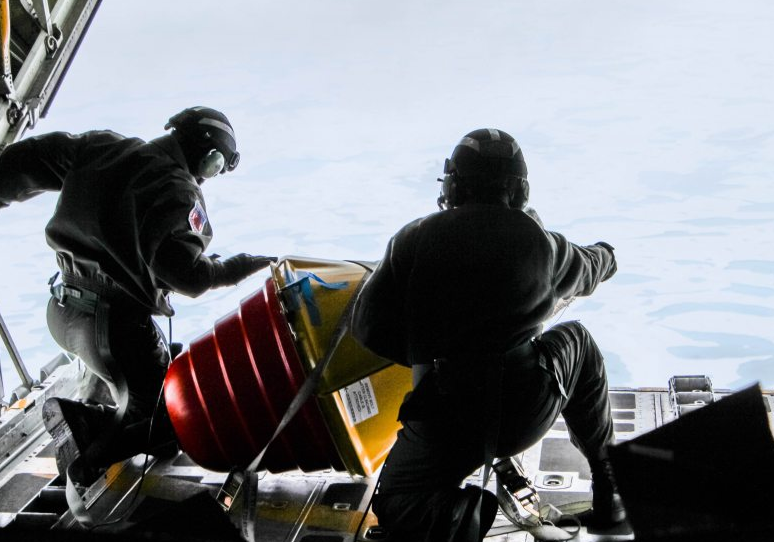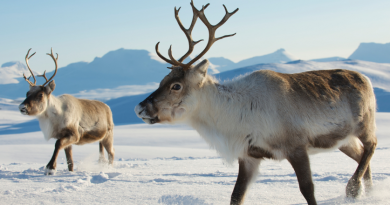U.S. Coast Guard and scientists on Arctic mission

KODIAK — It’s about 5:45 a.m. on a dewy Tuesday morning, and an enthusiastic climatologist is preparing to board a U.S. Coast Guard flight over Arctic sea ice.
Ignatius Rigor checks a giant buoy, which looks like a bright red and yellow toy, in the expansive aircraft warehouse. Rigor is here from Seattle to ensure his special meteorological tool is dropped into the sea with immaculate precision. It has to fall between cracks in the ice at a location about 130 miles northwest of Deadhorse.
“It’s a little nerve-wracking because we’re pitching out a $20,000 instrument, but it’s exciting,” he says before the plane takes off. “It’s my favorite part of the job.”
A beeping forklift takes his buoy away and loads it onto a Coast Guard C-130 parked outside.
‘Arctic Domain Awareness’
As the thawing Arctic Ocean opens to vessel traffic and economic activity, the Coast Guard is being tasked with shouldering more responsibility for overseeing the U.S. portion of it. To boost Coast Guard presence in the region, the Alaska district has been conducting annual Arctic Shield campaigns. The periodic “Arctic Domain Awareness” flights, conducted between spring melt and fall freeze-up, are supposed to accomplish what their name implies: boost understanding of the far-north region where the Coast Guard has new responsibilities.
To help with these deployments and to help train its crew, the Coast Guard makes a practice of bringing scientists aboard its Arctic Domain Awareness flight — especially the University of Washington team, which has been accompanying the Coast Guard for years.
The buoys deployed by the team, Rigor says, are the next best things to having a person standing at the drop-off point with a thermometer.
If Rigor’s mission is a success, his buoy will be the first weather device in its area to transmit valuable measurements of wind, sea-level pressure and surface temperature from that slice of the Arctic.
Real-time data
The mission is part of the International Arctic Buoy Program, which provides real-time data for climatologists forecasting weather and ice conditions in what is otherwise an informational dead zone.
The data it transmits could help the region’s growing maritime industry avoid sending cargo and crews into the worst Arctic storms.
Without these buoys, forecasters have to guess what the weather, ice and sea are doing or will do in these areas.
“Our goal is to have an array of perfectly spaced buoys every 250 kilometers,” Rigor says.
Rigor came to Kodiak with five other scientists from the University of Washington who are also pursuing climate and ice projects. The university just started its second four-year endeavor to monitor more than a dozen climate variables in the Arctic — including air pressure, temperature, wind patterns and ice behavior — and how they all interact. The efforts are largely funded by the U.S. Office of Naval Research.
Rigor’s is the most expensive device on the plane. The others have $1,500 and $20 probes, and more of them. But every instrument drop has a specific destination that requires precision.
Deploying the Buoys
Just before 8:30 a.m., co-pilot Lt. Hunter Atherton gathers everyone in the cabin and gives a brief rundown of what to expect. First, the plane will head to Fairbanks for fuel; then it will take off again and slowly descend near Deadhorse. When it’s time, the crew will open the back end of the C-130 and, one by one, drop each piece of measuring equipment according to its specific requirements.
“We’ve got a lot to do today,” Atherton says.
Soon the C-130’s doors shut. Ears are plugged and noise-canceling headphones are on. There are 15 rickety commercial airline seats with ragged blue fabric in the belly of the plane, where all the researchers sit. There are no windows by the seats, but passengers can easily get up to find one. Nearly every inch of the plane is covered with safety, science or flight equipment.
Two friendly Coast Guard drop masters sit behind the cockpit on each side with their own windows, one more experienced and one in training. They are the ones who will open the back and push, throw or simply let go of the equipment when the time is right.
“Routine stuff,” the more experienced one says.
Researchers are dozing for a few minutes after takeoff, tinkering with their tools or filling out a crossword puzzle.
Around 1 p.m. the plane is northwest of Deadhorse, above the target coordinates, and is ready to start dropping the first set of measuring devices from about 1,000 feet. The back opens to a bright white cloud cover split by a brilliant blue sky. The first measuring devices resemble tiny plastic rockets the length of a forearm.
Measuring water, temperature and depth
Drop masters are harnessed to the plane. They walk to the edge and take turns tossing the probes. When one hits the air, a deep red parachute explodes, contrasting the white and blue outside. The pilots circle until they receive word that the pop-up computer lab in the belly is receiving the probe’s data.
The next set of probes measure the velocity of water flow, temperature and depth — information that will help the scientists understand the sea’s melting and freezing processes. The probes must hit the water near the edge of the ice. But when the back of the plane opens again, at about 400 feet of altitude, the fog is blinding, impossible to see through without a trained set of eyes like Rigor’s.
“If you stare hard enough, you can see sea ice,” he yells over the roar of the C-130 engines.
But staring into it is like staring at a deep well of fluorescent lights. It takes a few minutes to see what he sees, and the plane has to get even lower for it to happen. Not until about 2:45 p.m. is the sea ice close up and in plain view. It looks like scales of white and brown with occasional pockets of baby blue. It’s brilliant.
The probe is deployed and the plane ascends back into the fog before the next drop.
Drop masters
Almost everyone on the sea-ice flyover is analyzing ice through data they’re collecting — not by what they can see out the windows. The pilots are getting input from the navigators, who are using instruments to steer toward cracks in the ice and determine when to descend through the fog.
Chatter on the headsets between the pilot and one of the drop masters reflects, after the lengthy process to plan and position, how quickly these drops happen. The navigator spots what he thinks is a hole in the ice. The pilot tells the drop master that he’s giving him a 15-second warning before he should release the next probe. As the plane approaches the hole the pilot calls “Drop! Drop! Drop!” into the headset.
There’s silence.
“How’d it go?” he asks.
“Good,” the drop master responds.
“Hit the water?” the pilot asks.
“Sure did.”
It’s about 5:40 p.m. and time to unload the last, most expensive piece of equipment. The drop masters start pushing Rigor’s buoy toward the C-130’s rear opening. Both of them have to push this one.
Rigor stands about 15 feet back with his camera rolling. The drop masters are crouching. They unhook its belt and roll it off the edge. A parachute releases and Rigor waits. He checks to make sure it’s transmitting data, turns around and gives a big smile with two thumbs up. Researchers start repacking what’s left of their gear and everyone is seated and tired by the time the C-130 lands in Kodiak at about 8:30 p.m.
Understanding climate
Data from these missions will be used to help understand patterns in the ice’s melting and search for trends relevant to climate change around the world. For example, researchers at the University of Washington have started to recognize that when ice melts, the fresh water remains close to the ice’s edge instead of dispersing, which could be preconditioning it for the next freeze.
“Our hope is to eventually understand preconditioning and make predictions,” says Sarah Dewey, whose probes were the second bunch to be deployed.
After landing, Atherton says that for the Coast Guard, adding scientists to awareness flights is about more than contributing to climate science. It also allows them opportunities to practice navigating and operating in the Arctic.
At other times, the C-130s are used for search-and-rescue missions and for aid drops. If a village or vessel needs supplies, the C-130 crew will likely be the one to drop them.
“But without these guys, there’s nothing to practice dropping,” Atherton says.
As for the scientists taking daylong roller-coaster rides through the skies above the Arctic — not a trip for the queasy — they gain access to places few other people get to see.
“It’s like going to Mars,” Rigor says. “It never gets old.”
Related stories from around the North:
Canada: Canadian Rangers – The Watchers, Radio Canada International
Denmark: Nordics to step up security cooperation on perceived Russian threat, Yle News
Russia: Russia’s Northern Fleet plans large Arctic exercise in 2015, Barents Observer
Norway: Norway must ramp up military in response to Russia: report, Barents Observer
Russia: Russia responds to Arctic NATO drill, Barents Observer
Sweden: Activists arrested in Sweden during Arctic military exercise, Radio Sweden
United States: U.S. Arctic rep: Russia’s Arctic buildup not necessarily martial, Alaska Public Radio Network



